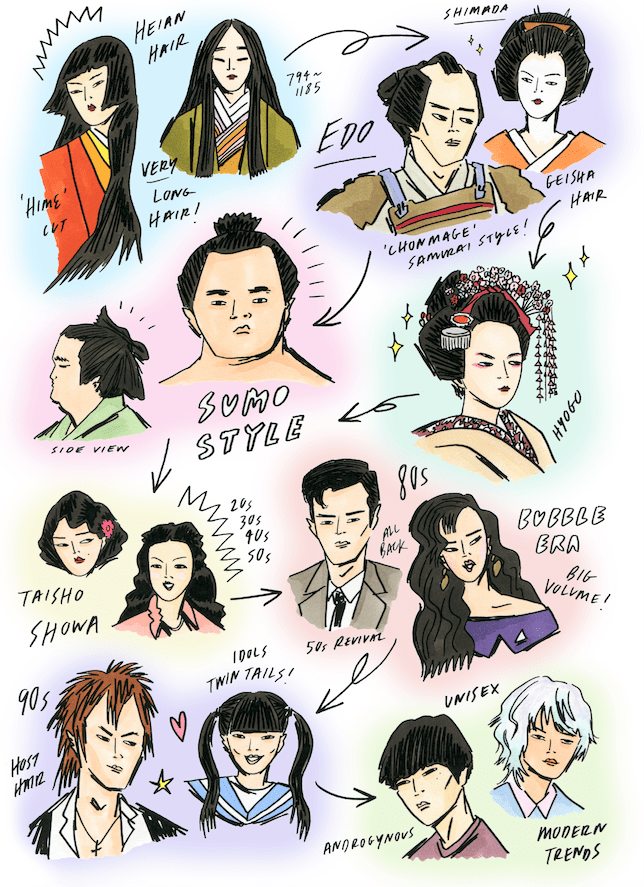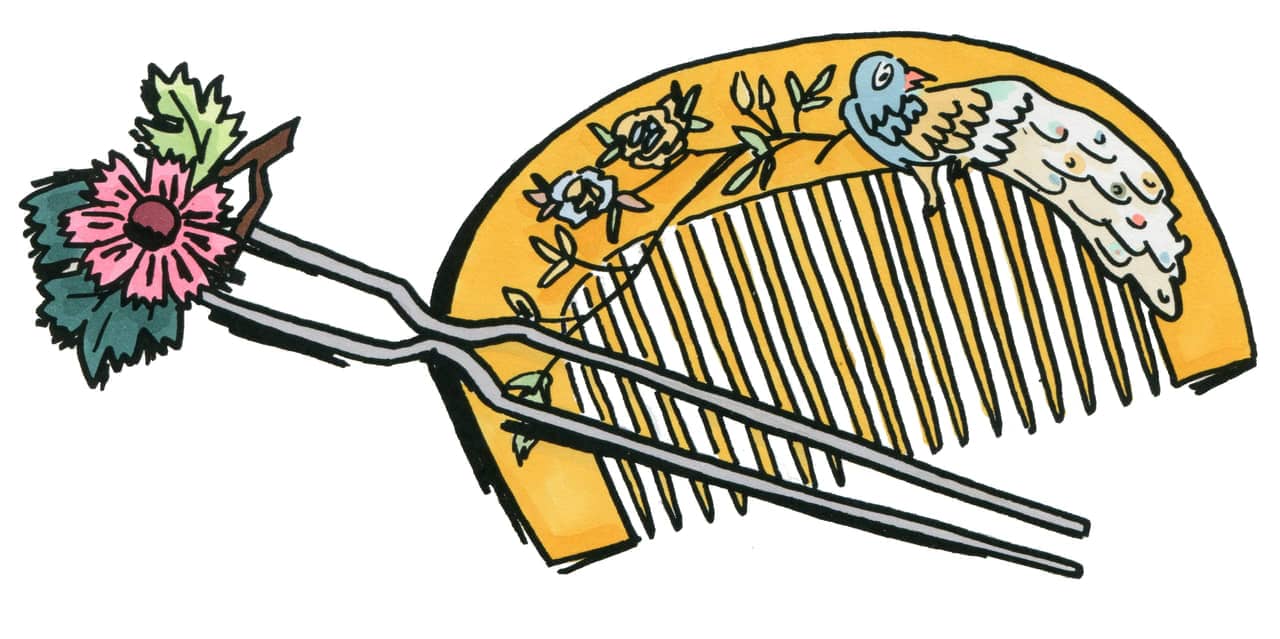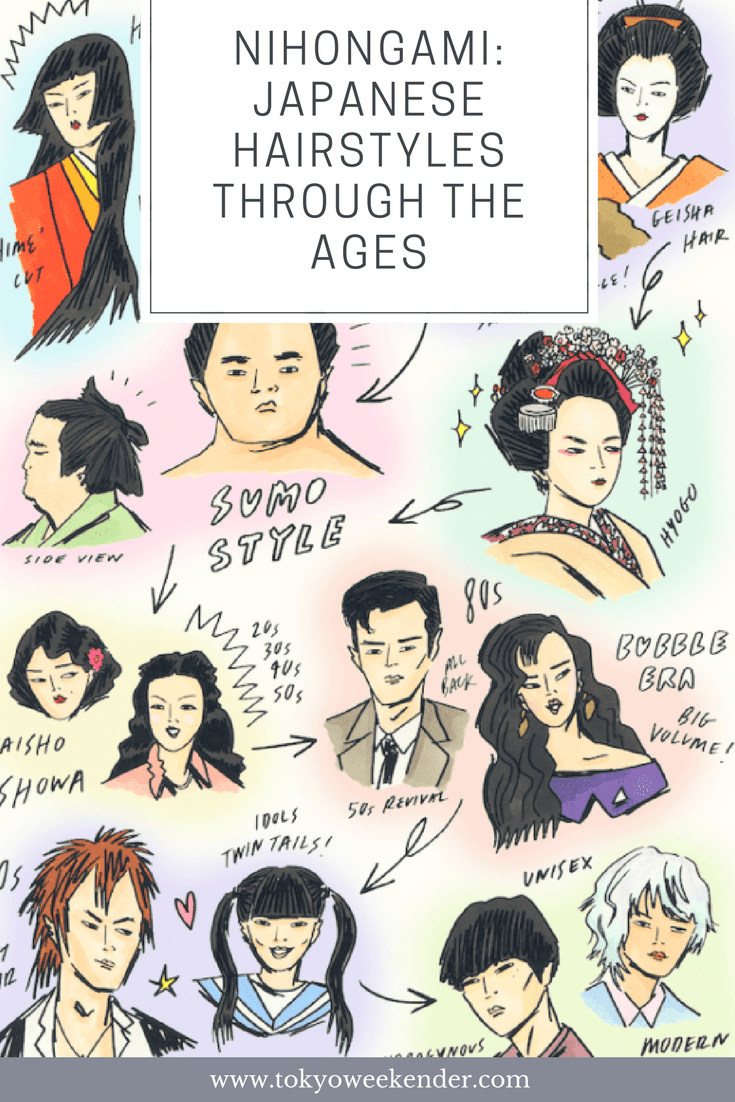Nihongami literally translates to “Japanese hair” and covers the various hairstyles from the Kofun period (250-538) to the early Showa period (1926-1989). We take a look at how nihongami has evolved and been shaped by cultural changes throughout the history of Japan.
 Early Japan was strongly shaped by Chinese culture, but by the Heian period (794-1185) noble courts rejected these influences. Heian aristocrats were notably particular about their fashion, and their beauty standards were exceptionally high. Women grew out their hair and wore it straight in the style depicted in the famous illustration from The Tale of Genji. Washing the hair was an arduous task, especially since noblewomen could barely move in their 12 layers of kimono – attendants had to do most of the work.
Early Japan was strongly shaped by Chinese culture, but by the Heian period (794-1185) noble courts rejected these influences. Heian aristocrats were notably particular about their fashion, and their beauty standards were exceptionally high. Women grew out their hair and wore it straight in the style depicted in the famous illustration from The Tale of Genji. Washing the hair was an arduous task, especially since noblewomen could barely move in their 12 layers of kimono – attendants had to do most of the work.
After the Heian period, hairstyles slowly became more elaborate – we’ll skip to the Edo period (1603-1868), which was a golden era for nihongami. During this time, the vast number of hairstyles recorded through ukiyo-e prints and other materials was unprecedented. This era saw the rise of merchants and merchants’ wives who drove popular fashion, as they had the means and the time to spend on such frivolities. Samurai and their families had status and controlled the government, but were limited financially.
The shimada was one of the many styles that became popular (of which there are multiple types) but it generally featured wide parts to the sides by the ears and was pulled up into a bun at the top or back. Each type of hairstyle was a visible indicator of a woman’s status or role in society – a widow would carry a different coif from a young unwed girl. Hair accessories and combs would be inserted into the hair, making them very heavy – especially if extra hairpieces to add volume were inserted. These hairstyles were meant to last for several days – even up to a week – and were held in place by wax.
Similar styles can be seen on modern geisha and maiko, though they have an even broader range of designs. One of the most elaborate styles – known as hyogo – spreads the hair bun at the back into a butterfly shape. Courtesans wearing this style during the Edo period would also shave the hair at their temples and forehead to form a widow’s peak.
With the Meiji Restoration (1868), a rush towards Western trends and styles drew forth, especially visible in the Taisho, and Showa periods that followed. Men drove the change in fashion and hair at this point – leaving behind status symbols like the chonmage (topknot) hair of samurai and favoring shorter cuts and mustaches. Women were more restricted, but slowly started changing too – first with their hair, and then by postwar Showa eventually shedding the kimono as daily wear.
Though the traditional nihongami style technically ended with the Showa period – it’s a style almost synonymous with the wearing of kimono – young Japanese people have continued to find creative ways to express themselves through their hair. The 1980s bubble era cuts and waves, as well as the 1990s spiked host hair (that lasted well into the 2000s!) are still clear indicators of those time periods. Currently, trends are leaning towards more unisex and androgynous looks, with more daring color palettes for both men and women. What will the next chapter of modren nihongami look like? Only time will tell.
 Where to Experience Nihongami
Where to Experience Nihongami
If you would like to try a nihongami hairstyle using your natural hair (or with hair attachments), visit Seiko Sawada, a professional kamiyuishi (traditional Japanese hairstylist) in Miyagi. She opened her salon in 2017 and also offers photos sessions where you can dress up as an oiran courtesan, a historic court noble, or a maiko or geisha.
For Nihongami beauty parlor Sawada’s contact information, visit our Concierge listing.
Illustrations by Bunny Bissoux
Updated On April 26, 2021


 Where to Experience Nihongami
Where to Experience Nihongami







